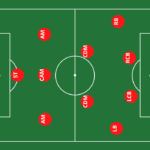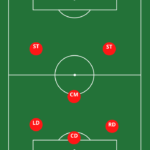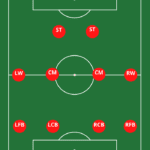
- Last Updated -
Exploring the World of Soccer Relegation
Soccer is one of the most popular sports in the world, with millions of fans and players alike following various leagues and tournaments. The rules and structure of the game can be complex, but one aspect that often stands out to fans and players alike is the concept of promotion and relegation.
Promotion and relegation refers to the system by which teams move between different levels or divisions within a league based on their performance. At its core, it incentivizes teams to perform at their best to avoid getting relegated down a level or achieve promotion up a level.
In many ways, this system adds an extra layer of excitement to soccer as it keeps things interesting for fans right up until the end of a season. Several leagues around the world use this system, with perhaps none more famous than England’s Premier League.
Promotion/relegation has become so synonymous with English football that it’s almost impossible to think about one without instantly thinking about the other. But how does relegation work?
And what impact does it have on both players and teams? To understand this, we first need to define what exactly we mean by “relegation zone.” Put simply, this refers to the bottom few teams in a given league who are at risk of being relegated down one division based on their overall performance throughout a season.
The psychological impact of this system can be intense for those involved. Teams who are fighting against relegation are often under immense pressure as they battle against each other for survival.
And when you consider that getting relegated could mean fewer resources (such as revenue from TV deals), fewer star players signing on for your team, or even job losses for coaches and staff members–it’s easy to see why there are pros and cons associated with this approach.
All that being said though, despite some potential drawbacks in certain situations–the overall benefits of using promotion/relegation far outweigh any negatives in most cases.
It helps keep things interesting and competitive throughout the season, and it makes the whole experience that much more exciting for fans watching from home or in the stands. In the next few sections, we’ll dig deeper into how this system is used around the world, as well as explore some alternative league systems that have been proposed in recent years.
Spanish LaLiga
| Level | League/Division (Wikipedia) | League/Division (Sami/Ertheo) | Teams/Clubs |
|---|---|---|---|
| 1 | Primera División (LaLiga EA Sports) | La Liga | 20 teams |
| 2 | Segunda División (LaLiga Hypermotion) | Segunda División | 22 teams |
| 3 | Primera Federación | Segunda División B | 40 clubs in 2 groups (Wikipedia) / 80 teams in 4 regional groups (Sami) / Over 440 teams in many regional groups (Ertheo) |
| 4 | Segunda Federación | Tercera División | 90 clubs in 5 groups (Wikipedia) / Teams in 18 regional groups (Sami/Ertheo) |
| 5 | Tercera Federación | – | 324 clubs in 18 groups (Wikipedia) |
Deciphering Relegation in Soccer
In the world of soccer, promotion, and relegation are two concepts that shape the very structure of competition. Relegation is a process whereby teams that finish at or near the bottom of their league are demoted to a lower division for the following season. Conversely, promotion is an opportunity given to teams in lower divisions to compete in higher ones if they perform well.
The concept of relegation may seem straightforward on paper, but there’s much more to it than meets the eye. Firstly, let’s dive into the mechanics of how relegation works.
In most leagues, teams play each other twice over a season – once at home and once away. The team with the most points at the end of these fixtures wins the league title and gains automatic promotion to a higher division if there is one.
The team that finishes second also gains automatic promotion. However, teams that finish third or lower can still gain promotion through playoff matches against other similarly placed teams from different divisions.
Now let’s explore what exactly makes up what is known as “the relegation zone.” This refers to any position in which a team is likely to be relegated unless they can improve their performance quickly enough before the end of the season. The exact number of places in this zone varies depending on league structure – some may have just one or two positions that lead to automatic demotion while others have more.
One important consideration when it comes to understanding relegation is its impact on team psychology. For clubs and players alike, being relegated can be devastating both financially and emotionally.
Some players may choose to leave for better pastures while others may struggle with self-doubt and loss of morale after experiencing failure. Of course, there are pros and cons associated with using relegation in soccer as well as alternative league systems available worldwide.
On one hand, it can provide an extra incentive for teams who might otherwise not push themselves as hard during games – after all, no one wants to be relegated. On the other hand, it can also lead to a lack of meaningful competition at the top levels where certain teams are always guaranteed a place in the top division.
Germany Bundesliga
| Level | Description | Teams | Format |
|---|---|---|---|
| Bundesliga | Top professional division in Germany, consisting of 18 teams. Features the highest level of German football. | 18 | Each club plays every other club once at home and once away. The two teams at the bottom of the table are relegated into the 2. Bundesliga, while the top two teams in the 2. Bundesliga are promoted. The 16th-placed team in the Bundesliga and the third-placed team in the 2. Bundesliga play a two-leg play-off match. The winner of this match plays the next season in the Bundesliga, and the loser in the 2. Bundesliga. |
| 2. Bundesliga | Second tier of German football, also featuring 18 teams. The top teams are promoted to the Bundesliga. | 18 | Similar to Bundesliga, each team plays 34 games. The top two finishers in the 2. Bundesliga are automatically promoted to the Bundesliga, and the bottom two finishers are relegated to the 3. Liga. The third-from-bottom club in the Bundesliga will play a two-legged tie with the third-place team from the 2. Bundesliga, with the winner taking up the final place in the following season’s Bundesliga. |
| 3. Liga | Third tier, with a mix of professional and semi-professional teams. It includes 20 teams. | 20 | 20 teams compete for promotion to the 2. Bundesliga. The first two teams are promoted directly, the third in the table has to play for promotion in two playoffs against the third from the bottom of the 2. Bundesliga. The bottom four teams are relegated to the fourth-class Regionalliga. The four best teams in the league qualify for the DFB-Pokal. |
Demystifying the Mechanics of Relegation
Relegation is a term used for a process by which a team moves from a higher division to a lower one, based on their performance during the season. It’s one of the most important aspects of football as it keeps the competition exciting and prevents complacency among teams.
However, relegation can also have a significant impact on the psychology of players and fans alike. The primary mechanics of relegation are straightforward.
The teams that finish at the bottom of the table at the end of each season are relegated to a lower division while those that perform well get promoted to higher tiers in their league system. This system serves as an incentive for teams in lower divisions to push harder and achieve better results so that they can be promoted.
In football, there is usually an established criteria or points system that determines which teams will be relegated or promoted. For example, in England’s Premier League, three teams with the lowest scores at the end of each season get relegated while three teams from the Championship (second tier) get promoted.
It’s important to note that relegation doesn’t just affect individual clubs but has broader implications for entire communities and cities. Fans invest heavily in their local clubs both financially and emotionally, so when they see them get relegated it can be devastating.
However, there are also several benefits to using relegation in soccer leagues. One advantage is that it helps level out the competition by promoting meritocracy over wealth or status; smaller clubs have an equal chance to make it into higher divisions if they perform well enough.
Additionally, promotion and relegation keep games competitive until the very end of each season since every team’s performance has real stakes attached to it. Overall, while there are some cons associated with using relegation systems in soccer leagues such as its psychological impact on players and fans alike; its pros outweigh them significantly making promotion-relegation popular worldwide.
Deep Dive into the English Premier League
The English Premier League (EPL) is one of the oldest and most prestigious soccer leagues in the world. It has given us some of the most memorable moments in soccer history with a rich tradition of competition and excellence.
The league comprises 20 teams who play each other twice, once at home and once away, for a total of 38 matches per season. But what sets the EPL apart from other soccer leagues is its unique promotion and relegation system.
In the EPL, the bottom three teams at the end of each season are relegated to the next tier called the Championship, while three teams from that league are promoted to play in the EPL for the following season. This means that there is always a high level of competitiveness and pressure on every team to perform well throughout their season.
The stakes are incredibly high as any slump in form or loss can mean being relegated from one of Europe’s richest leagues. The relegation system is not only exciting for fans but it has also been credited with creating a level playing field where smaller clubs can compete against more established ones by giving them a chance to rise through lower divisions until they reach their desired level.
Additionally, this creates an incentive for teams to invest in their youth academies as they can groom players who can help them stay up when they eventually get promoted. However, relegation also has its drawbacks.
Teams that have been relegated often suffer significant financial losses as broadcasting rights fees drop significantly when they move down a division. This makes it harder for those teams to compete with those that remain in higher divisions which could create long-term stagnation or even demise if not handled correctly.
Despite some negatives, many argue that relegation systems provide essential benefits that help maintain quality control over professional football seasons worldwide. It levels out opportunities for small clubs while ensuring established ones stay competitive by forcing them to perform continually at peak levels each season.
The Intricacies of the Relegation System in the EPL
The English Premier League (EPL) is a prime example of how soccer promotion and relegation work in practice. It consists of 20 teams that compete against each other every year, with the ultimate aim being to win the league title or achieve one of the coveted Champions League spots. However, for some teams, simply avoiding relegation is the primary objective.
The EPL’s relegation system is complex and adds a layer of pressure to teams. To qualify for the EPL, a team must either have been promoted from the lower-tier Championship division or have avoided being relegated from last season’s EPL.
The bottom three teams in the EPL at the end of each season are relegated to the Championship division and replaced by three promoted teams from that league. This means that there is always a sense of flux within both leagues as new teams are promoted and existing ones are demoted.
The relegation zone refers to those positions in which a team can be relegated if they finish them at the end of a season. In simple terms, this means any team finishing in 18th place or below will find themselves playing in lower-tier leagues next season.
This creates immense pressure for teams trying to avoid this fate. In turn, it leads to some intense matches between struggling clubs who cannot afford to lose points.
One significant effect of this system is its impact on team psychology; knowing that your club’s future hangs on every result can be incredibly stressful for players, staff, and supporters alike. But it also adds an extra dimension of excitement as fans follow their team’s fortunes throughout the season.
There are pros and cons associated with using relegation as part of soccer relegation systems like those used by EPL clubs. On one hand, it ensures that only competitive teams remain in top-tier leagues, which strengthens overall quality standards while giving smaller clubs opportunities to succeed at high levels based purely on merit instead of money alone.
On the other hand, its cons include pushing clubs into financial instability if relegated, and a loss of support from fans who are upset they won’t see their team play against top opponents. Overall, the intricate system of promotion and relegation in soccer is a fascinating one to follow.
It ensures that teams always have something to play for throughout the season and helps to keep competitions exciting until the very end. While there are certain drawbacks associated with this system, its pros make it an important feature of global practices in soccer promotion and relegation.
Analyzing the Teams’ Experiences within the Relegation Zone
When a team finds itself in the relegation zone, the experience can be one of immense pressure and anxiety. Suddenly, the stakes of every match are much higher, and players can feel as though their entire career is riding on each game. The impact of relegation on team psychology cannot be understated, as the threat of being sent down to a lower league can have profound consequences on players’ mental health and well-being.
For teams that have never experienced the relegation zone before, it can be a shock to suddenly find themselves fighting for survival. The pressure to perform at an extremely high level every week can be overwhelming, and it’s not uncommon for teams to struggle under this added pressure.
However, for teams that are more familiar with being in the relegation battle year after year, this experience can be almost routine. One downside of the relegation system is that it often leads to increased player turnover.
When a team gets relegated from one league to another, they may lose some of their best players who want to continue playing at a higher level. Additionally, when a team gets promoted from a lower league to a higher one, they may need to bring in new players who are better suited for the increased competition.
Despite these potential downsides, there are many proponents of using promotion and relegation in soccer leagues around the world. One main advantage is that it ensures that every team has something meaningful to play for throughout the season – even if they’re not competing for titles or European places.
Furthermore, because promotion and relegation are used widely across different countries and leagues globally; this creates an exciting prospect where clubs from different regions compete against each other which brings more excitement to fans worldwide. Analyzing the teams’ experiences within the relegation zone highlights how high-stakes soccer relegation rules affect individual players and clubs both positively and negatively.
While some may argue that there are cons inherent in using promotion and relegation in football, it is important to weigh them against the many pros of this system, which provides incentives for teams to perform at their best throughout the season.
Understanding the relegation zone definition and global practices of promotion and relegation in soccer can offer insights into alternative league systems worldwide and how they might impact the future of soccer.
Understanding the Relegation Zone
The relegation zone is a term that causes anxiety among soccer fans all over the world. In leagues that use a promotion and relegation system, teams that finish at the bottom of the table are relegated to a lower league, while those at the top move up. The relegation zone refers to the area closest to the bottom of the table, where teams are in danger of being relegated.
It’s typically comprised of the three or four teams with the lowest number of points. Being in the relegation zone can be a daunting experience for players and fans alike.
Teams often struggle with confidence and motivation when they find themselves in this position. The psychological impact can be significant, as players become more desperate to secure points and avoid being relegated.
This pressure can sometimes lead to rash decision-making on and off the field. Soccer relegation rules vary depending on which league you’re looking at, but there are some general principles that most follow.
In most cases, it’s based on points accumulated over a certain number of games – generally an entire season. Those who finish in the bottom few spots will be relegated automatically while others may have to go through playoffs against teams from lower divisions.
While some argue that using promotion and relegation in football is a great way to maintain competitiveness throughout a league, others claim it has downsides too. One such problem is inconsistency between different leagues’ rules for promotion and relegation – this makes comparing different leagues difficult since each has its own way of doing things.
All in all, understanding what constitutes as being in “the relegation zone” is crucial for any soccer fan looking to grasp how relegation works within their favorite sport. With its impact on team psychology being so profound when hovering around said “zone”, it’s clear how much weight this term carries within soccer culture.
Weighing the Pros and Cons of Relegation
When it comes to soccer relegation, few topics spark as much debate as promotion and relegation. It’s understandable why there are strong opinions on both sides of the issue. On one hand, relegation can be seen as a motivating force for teams to perform at their best every season.
On the other hand, it can be incredibly demoralizing for a team and its fans to be relegated to a lower league. Let’s start with the pros of using relegation in soccer.
One major advantage is that it creates intense competition and incentivizes teams to play their best throughout the season, regardless of whether they’re at the top or bottom of the table. It also allows smaller clubs with less financial backing to rise up through the ranks and make a name for themselves in higher leagues.
Fans of these smaller clubs often have an incredibly passionate bond with their team and relish the chance to see them compete against more established opponents. However, there are also many cons associated with relegation rules in football.
One major issue is that it can create significant financial instability for teams who are relegated from higher leagues due to lost revenue from lower TV deals and reduced ticket sales in smaller stadiums. This can lead to struggles on and off the field, which has happened numerous times throughout history with many clubs falling into deep financial trouble after being relegated.
Another con is how being stuck in the relegation zone affects team psychology over time. If a team spends too long hovering near or below this dreaded line, they may become demoralized – even if they have high-quality players on their roster capable of playing at a higher level.
Additionally, some argue that promotion and relegation can limit diversity among teams by perpetuating an ‘elite’ class of successful clubs while keeping others stuck in low leagues indefinitely. Despite these valid concerns about soccer relegation promotion relegation systems, it’s clear that there’s no one-size-fits-all solution when it comes to alternative league systems in soccer.
This is why it’s so important to explore global practices of promotion and relegation – seeing how other countries handle these issues can provide valuable insights into what may work best in the long run. Ultimately, it’s up to fans, players, and officials alike to determine the best path forward for soccer leagues around the world.
Charting a Path Forward
Now that we have explored the intricacies of promotion and relegation in soccer, it is time to chart a path forward. It is clear that the relegation system has both its pros and cons.
On the one hand, it creates an exciting and competitive league environment where every team is fighting for survival. On the other hand, it can be devastating for teams that are relegated as they lose out on sponsorship deals, ticket sales revenue, and lucrative TV broadcasting rights.
One possible solution to mitigate the negative impact of relegation is to explore alternative league systems in soccer. For example, some leagues have introduced a playoff system where teams compete for promotion at the end of the season rather than being automatically promoted based on their performance throughout the year.
This could provide more opportunities for mid-table teams to compete for promotion while still maintaining some level of competition between teams at risk of being relegated. Another possibility is to adopt a hybrid system where teams are not automatically relegated but must instead compete in play-off matches against lower division teams.
This would help reduce the psychological impact of relegation on players and fans while also providing more opportunities for smaller clubs to compete at a higher level. It is also important to consider global practices of promotion and relegation when charting a path forward.
Countries such as Australia use a unique system where two divisions coexist but do not interact with each other during regular seasons. Instead, there are playoffs between top-performing teams from both divisions who then compete against each other for promotion or avoiding relegation.
We must recognize the impact that relegation has on team psychology and emphasize strategies that can help prevent or alleviate this burden. Teams in or near the relegation zone often experience increased pressure from fans and media alike which can negatively affect their performance on the pitch.
Overall, charting a path forward requires collaboration between stakeholders including football associations, club owners, players, coaches, and fans alike.
While there may not be a one-size-fits-all solution to promotion and relegation in football, by exploring alternative league systems, learning from global practices, and prioritizing player well-being, we can create a future that is both competitive and fair.
Importance of Exploring Alternative League Systems
While promotion and relegation are widely used in soccer, there are alternative league systems that can be explored. These alternative systems come with different pros and cons. It is important to understand these alternatives and their implications on the game to make informed decisions about the best system to use.
One major alternative to the promotion and relegation system is a closed league system where teams cannot be relegated or promoted based on performance. This type of league is common in North American sports such as basketball, baseball, and football.
One advantage of a closed league system is that it can provide stability for franchises, which can attract sponsors and investors knowing they will remain in the same league regardless of performance. However, a major disadvantage of a closed league system is that it takes away incentives for teams to perform at their best since they cannot be relegated or promoted.
This could lead to less exciting matches without the same level of intensity seen in leagues that use promotion and relegation rules. Another alternative league system used in soccer is the franchise model where owners buy into a team rather than having an open market for players like other leagues.
This model has been used successfully by Major League Soccer (MLS) in North America and allows franchises to have more control over finances. However, this model also comes with drawbacks such as limiting competition between teams from different regions or countries due to financial constraints on traveling expenses.
The franchise model also limits player salaries which could impact recruitment efforts for highly skilled players. The global practices of promotion and relegation have grown significantly over time as other countries have adopted this system.
While alternative systems may provide some advantages such as reducing risk for team owners, they may ultimately diminish excitement around matches within leagues. Ultimately, exploring these various models will allow us to make informed decisions about how we want soccer games structured moving forward into the future.
France LIGUE
| Level | Description | Teams | Format |
|---|---|---|---|
| Ligue 1 | Top professional division in France. Administered by the Ligue de Football Professionnel. | 18 | Each club plays 34 matches over the course of the season, playing each other twice (home and away). Teams receive three points for a win and one point for a draw. At the end of the season, the club with the most points is crowned champion. The system operates on promotion and relegation with Ligue 2. |
| Ligue 2 | Second tier of French football. Also administered by the Ligue de Football Professionnel. | 20 | Each club plays 38 games in a season, playing each other twice. Teams are ranked by total points, goal difference, and then goals scored. The top two teams are promoted to Ligue 1. The fourth and fifth-place finishers compete for a chance to play the 16th-placed team in Ligue 1 for promotion. The three lowest-placed teams are relegated to the Championnat National. |
| Championnat National | Third division of French football, consisting of a mix of professional and semi-professional clubs. | 18 | Each club plays a total of 34 games, once at their home stadium and once at that of their opponents. The first and second place finishers are promoted to Ligue 2. The six lowest placed teams are relegated to the Championnat National 2. |
Thi
Discovering Variations of the Promotion and Relegation System
One of the unique features of promotion and relegation in football is the variety of ways it can be implemented. There are many alternative league systems in soccer that have been used or proposed, each with their own pros and cons.
Some leagues use a playoff system to determine promotion and relegation, while others have multiple tiers with different numbers of teams. Many leagues also have different rules for how teams move between divisions.
One example of an alternative league system is used in the United States and Canada. Major League Soccer (MLS) uses a single table format, meaning there are no divisions or tiers.
Instead, there is a regular season and then a playoff tournament to determine the champion. While this system has its advantages, it lacks the drama and excitement of relegation battles that fans in other countries enjoy.
In India, the football league system has undergone significant changes recently with the formation of the Indian Super League (ISL). This league was created as a separate entity from the existing I-League and features a franchise-based model similar to American sports leagues.
While this model has been successful in terms of attracting investment and increasing interest in football in India, it eliminates traditional promotion and relegation. Mexico uses a unique system known as “ascending and descending” or “ascenso y descenso”.
The Mexican football pyramid contains several different leagues at various levels, with promotion between them determined by playoffs rather than simply being based on final standings. While these variations on promotion and relegation rules exist around the world, there are still many countries where it remains an integral part of their football culture.
In fact, most global practices of promotion and relegation follow similar principles as those seen in England’s Premier League. Regardless of which specific system is used, one thing is clear: relegation can have a significant impact on team psychology.
For teams that find themselves battling against relegation throughout a season, every point becomes crucial as they fight for survival. On the flip side, teams that are successful in avoiding relegation or gaining promotion can experience a boost in confidence and momentum that carries over into the following season.

Analyzing Promotion and Relegation Practices Worldwide
While the English Premier League is arguably the most well-known league utilizing promotion and relegation, this practice is actually a global phenomenon. Different leagues and countries have their own unique systems for determining which teams will move up and down. Let’s explore some of the various promotion and relegation practices worldwide.
In Australia, the A-League utilizes a unique system in which there is no official relegation zone. Instead, at the end of each season, the lowest-ranked team is given an opportunity to remain in the league by defeating a team from the second division in a playoff match.
This system has its advantages; it allows for greater stability within the league, as teams don’t have to worry about being relegated and losing valuable revenue streams. However, some critics argue that without true relegation consequences, teams may become complacent and content with mediocrity.
India’s I-League uses a more traditional promotion/relegation system. The bottom-placed team at the end of each season is automatically relegated to India’s second division, while the winner of that division earns promotion to replace them.
This system has been praised for promoting competitiveness within leagues and providing hope to smaller clubs who can potentially rise through the ranks. Mexico’s Liga MX uses two short seasons per year (Apertura & Clausura) with playoffs determining champions but also featuring relegation/promotion from one season to another based on points-per-game averages over three years.
Many fans appreciate this system as it creates more opportunities for new teams to make it into higher divisions or win championships through playoffs despite not having consistent high-level play throughout every regular season game. The United States and Canada use a franchise-based model without promotion or relegation in their top-tier professional leagues like Major League Soccer (MLS).
However, lower leagues like USL Championship (USLC) do utilize promotion/relegation systems between their different divisions: USLC Division 1 & Division 2 as well as multiple regional leagues. While promotion and relegation may seem like they have a set structure, the reality is that leagues all over the world have their own variations on this system.
Each league’s unique approach has its pros and cons, and fans will always debate which system is best. Understanding these differences can help soccer enthusiasts appreciate the nuances of each league’s format and how it affects team performance, revenue streams, and international competition.
1. Australia
Australia might not be one of the biggest soccer nations in the world, but it still has a robust promotion and relegation system in place. The A-League, which is Australia’s top-flight soccer competition, has been following a promotion-relegation system since its inception in 2005.
While the league’s governing body has toyed with the idea of introducing a closed league system, any attempts at that have been met with opposition from fans and stakeholders who believe that relegation is an essential aspect of modern soccer.
The Australian soccer pyramid features four levels, with the A-League at the top followed by National Premier Leagues (NPL) divisions for each state.
Below that are various semi-pro leagues that vary depending on each state. The teams finishing in first place in each NPL division then play against one another to determine who gets promoted to the A-League through a playoff format.
Relegation also takes place within the NPL leagues. Teams finishing last get relegated to lower divisions, while those finishing at or near the top of their respective Divisional leagues get promoted to higher-level NPL divisions.
This setup ensures that there is perpetual movement between different tiers of Australian soccer. One interesting fact about Australia’s relegation system is that it operates on a license-based model rather than pure meritocracy.
Essentially, every team competing within Australia’s professional leagues must meet specific criteria such as financial stability and stadium capacity requirements to secure a license to continue playing within their relevant league.
Despite some criticisms over this approach being too restrictive for ambitious clubs outside of traditional powerhouses like Melbourne Victory and Sydney FC, most stakeholders agree that it offers numerous benefits such as ensuring quality standards are maintained across all participating teams.
Overall, Australia’s promotion and relegation system may not be as well-known as other countries’, but it shows how even smaller soccer nations have adapted this practice for their own game development purposes. It will be intriguing to see how they continue to refine their system in a rapidly changing soccer landscape.
2. India
India, a cricket-loving nation, has recently seen the emergence of football as a viable sports option. In fact, the Indian Super League (ISL) has been gaining popularity since 2014.
However, India’s promotion and relegation system is quite different from the rest of the world. The country does not have a traditional promotion/relegation system in place yet.
Instead, India follows a franchise-based model for its football leagues where every team pays an entry fee to participate in the league. Teams are selected through bidding processes conducted by leagues/federations to determine who can compete in the league.
This model allows teams to retain their spots in top-flight competition without fear of relegation. The All India Football Federation (AIFF) has tried to introduce promotion and relegation models but it has met resistance from team owners who don’t want their investments affected by such changes.
As a result, clubs that perform poorly are often relegated to lower divisions within their own state associations rather than being demoted from top-flight competitions. Critics argue that this franchise-based model doesn’t encourage competition and can lead to complacency among teams since they don’t have much at stake if they win or lose games.
There is also no incentive for lower-tier teams to strive for excellence since there is no chance of promotion or being included in higher-tier competitions. Despite this criticism, there are some positive attributes about this system too.
This approach allows young players more opportunities to play at a professional level and provides them with exposure that can help them secure future contracts with bigger clubs around the world. Overall, India’s unique approach towards soccer promotion and relegation might be working for now, but it remains to be seen whether it will effectively develop future talent and sustain interest among fans over time.
3. Mexico
Mexico is also a country with a rich soccer culture, and their relegation system is particularly interesting. The first division in Mexico is known as Liga MX, and they use a similar system to the EPL, where the bottom three teams are automatically relegated to the second division known as Ascenso MX.
However, there are some differences worth noting. One of the unique aspects of the Mexican relegation system is that it takes into account a team’s performance over the past three seasons rather than just one.
This means that a team can potentially avoid relegation if they’ve performed well in previous seasons despite their current poor form. Another difference from other leagues is that if a team wins promotion from Ascenso MX, they must meet certain requirements set by Liga MX to prove that they have adequate infrastructure and finances to compete at that level.
Despite these nuances, there are still criticisms of Mexico’s relegation system. One argument is that it doesn’t fully reward teams for their current season performance since past performances have an impact on whether or not they get relegated.
Additionally, some argue that it hinders smaller clubs from being able to establish themselves in Liga MX since they’re constantly at risk of being relegated. However, those in favor of promotion and relegation point out how it adds excitement to matches for fans since every game has implications beyond just winning or losing.
It also incentivizes teams to perform well consistently rather than just relying on one good season before potentially falling apart. Overall, while Mexico’s relegation system has its own quirks and criticisms, it still falls in line with global practices of promotion and relegation seen across different countries.
4. United States and Canada
In North America, soccer operates in a vastly different way than in Europe. The United States and Canada have their own unique soccer leagues that operate without the promotion and relegation system.
Instead, they have a closed league system where team owners pay an entry fee to join the league. This means there is no opportunity for teams to move up or down between different levels of competition as they do in Europe.
Critics of this closed league system argue that it doesn’t allow for true competition and can limit the growth of the sport. Since there is no chance for smaller, less well-funded teams to move up into higher levels of competition, they may not be able to attract top-tier talent or investment from sponsors.
This can create a cycle where only the most financially stable teams are able to thrive. On the other hand, supporters of this system argue that it allows for more stability and certainty for team owners and investors.
They also point out that North America has a much larger geographic area than most European countries, which can make travel difficult and expensive if there were multiple tiers of competition. Despite this difference in league structure, North American soccer has still seen significant growth in recent years.
Major League Soccer (MLS) has expanded from 10 teams in 2004 to 26 teams as of 2021, with plans to add even more in the coming years. There have been discussions about implementing promotion and relegation into North American soccer leagues, but it would require significant changes to existing structures.
For example, lower division leagues would need more funding and investment to make sure all participating clubs are financially stable enough to compete at higher levels.
Overall, while promotion and relegation may not be present in North American soccer leagues at this time, the sport is still growing rapidly thanks to passionate supporters and dedicated team owners who are committed to expanding its presence across the continent.
5. The Global Standard
The Global Standard Promotion and relegation in soccer is more than just a sporting event. It’s a cultural experience that transcends borders, languages, and traditions.
Teams around the world utilize this system to create a sense of competitiveness and excitement within their respective leagues. While every country may have its own rules, there is still a global standard that binds all promotion and relegation systems together.
Soccer has become such a universal sport that it’s no surprise that the promotion and relegation model has been adopted across the globe. From Europe to South America, Asia to Africa, countries use this system to ensure that every team has an equal chance of success on the pitch.
What sets this system apart from others is how it creates an environment where teams are forced to compete for survival just as much as they are competing for titles. The global standard of promotion and relegation follows a simple set of rules: teams earn points throughout the season through wins and draws.
The team with the most points at the end of the season wins the league title while teams with fewer points fall into lower divisions. The number of teams relegated or promoted varies depending on relegations but usually involves two or three teams on either side.
While this system may seem fair on paper, there are pros and cons to using it in soccer leagues around the world. Some argue that it creates an atmosphere of consistent competition while others believe it can have negative psychological effects on players who fear being relegated.
Regardless of what view one takes, there’s no denying that promotion and relegation in soccer is here to stay – it has become ingrained in our sporting culture worldwide. Overall, understanding promotion and relegation in soccer requires more than just knowledge about rules or relegations; it demands an appreciation for its cultural significance too.
This model not only helps create excitement within leagues but also plays a role in shaping how we understand soccer as both sport and spectacle globally. As we continue to explore alternative league systems and reconsider the role of relegation, it’s up to us to determine how we want to continue this tradition and shape the future of soccer.
Conclusion: Recapitulating Key Insights
As we come to the end of this article, it is important to recapitulate some of the key insights we have uncovered about soccer relegation promotion relegation and its impact. For starters, we should commend the sport’s governing bodies for coming up with such a brilliant system that ensures fair competition and keeps things exciting all through the season.
Promotion and relegation in football is an essential feature that keeps fans engaged throughout the year. One thing we must stress is that understanding promotion and relegation rules as well as alternative league systems in soccer can be quite challenging.
However, with patience and a keen interest in the topic, anyone can grasp what it entails. We have looked at several variations of promotion and relegation practices worldwide, including Australia, India, Mexico, United States and Canada as well as The Global Standard.
It has become clear from our discussion that while promotion and relegation can be beneficial to some clubs by providing them with a pathway to ascend up the ranks; it can also have severe consequences on teams that are relegated from their domestic leagues or demoted from top-flight status in international competitions.
The impact of relegation on team psychology cannot be overemphasized; however, proponents argue that it fosters healthy competition among teams.
The concept of the relegation zone definition was also discussed extensively in this article. We explored how teams within this zone experience intense pressure towards the end of each season since they are vying for survival in their respective leagues or competitions.
Teams face stiff competition from those aiming to take their place; hence every match becomes crucial. We weighed both sides of using a relegation system.
The pros include promoting fair play by giving smaller teams an opportunity to compete at higher levels while encouraging larger clubs towards sustainability through healthy competition. On the other hand, there are cons such as disrupting team’s financial stability due to revenue loss when they fall into lower divisions.
Soccer relegation promotion-relegation is a fascinating topic that every soccer fan should be familiar with. While it can have its downsides, it remains an integral part of the sport and helps to keep up the level of excitement throughout the season.
It’s essential to understand how promotion and relegation work, as well as the impact it has on teams in and around the relegation zone. Exploring alternative league systems in soccer can provide us with insights into potential alternatives that could enhance our beloved sport even further.
Emphasizing the Significance of Grasping Soccer Relegation
Understanding the intricate world of soccer relegation is essential for anyone who loves and follows the sport. From players to coaches, fans, and even club owners, grasping soccer relegation can make a significant impact on how they see the game. One of the most crucial aspects of soccer relegation is promotion and relegation in football.
The system of promotion and relegation has been used in soccer leagues worldwide for many years. Teams are promoted or relegated based on their performance in their respective leagues during a season.
While some argue that relegation rules are harsh and can negatively affect teams’ psychology, others believe that it is an effective way to keep teams competing at their best level. One of the pros of using relegation in soccer is that it creates a more competitive environment.
Teams know that if they do not perform well enough to stay out of the relegation zone definition, they will be relegated to a lower league next season. This ensures that every team puts their best foot forward during every match, which ultimately leads to better performances from all teams involved.
While there are several advantages to using relegation rules in soccer leagues, there are also cons associated with this system. For one, being relegated can have a significant impact on a team’s finances since lower-league clubs receive less financial support than higher-league ones.
Additionally, being relegated can affect team morale negatively as it often means losing key players and having to rebuild from scratch. Alternative league systems in soccer exist outside of promotion and relegation rules; however, these systems are few and far between globally.
Australia’s A-League operates without promotion or relegation while India’s ISL has just implemented a system for regulated promotions after several years without one. Understanding the significance of grasping soccer relegation cannot be overstated enough, especially when it comes to promotion and relegation practices worldwide.
While many believe this system helps maintain competitiveness within leagues while also offering opportunities for smaller clubs to rise through the ranks, others see it as a harsh system that can negatively impact teams’ psychology. Regardless of one’s opinion, it is clear that promotion and relegation in football will continue to play an important role in shaping the sport for years to come.
Final Thoughts on the Future of Promotion and Relegation
As we come to the end of our discussion on promotion and relegation in soccer, it’s important to consider what the future holds for this system.
While it’s definitely not perfect, there are a lot of reasons to believe that promotion and relegation will continue to be an important part of the sport. One reason for this is that the relegation zone definition offers a clear incentive for teams to perform well throughout the entire season.
Knowing that their fate at the end of the year rests on their performance can push teams to give their all in every game, rather than simply coasting once they feel safe from relegation. This can lead to more exciting matches and higher levels of competition overall.
At the same time, soccer relegation rules do have some drawbacks. One major issue is that they can make it difficult for smaller clubs or those with less financial backing to break into the top tier.
This can create a situation where certain teams dominate year after year, while others are perpetually stuck towards the bottom of the table. Additionally, many people argue that there may be better ways to encourage competition and parity in soccer than through promotion and relegation.
Despite these concerns, there are still plenty of pros of using relegation in soccer – including its long history within the sport and its ability to create drama and excitement throughout a season.
For many fans, watching their team fight tooth and nail against relegation (or earn promotion back up) is one of the most thrilling parts of following soccer at any level.
Ultimately, whether or not promotion and relegation continues as a part of global practices of promotion and relegation in football will depend on how well it continues to serve its purpose within each league.
As alternative league systems in soccer continue to be explored around the world, it will be interesting to see whether other models – such as playoff-style systems or salary caps – gain traction as viable options for encouraging competitiveness while also promoting fairness across the board. (1)
FAQs - What is Soccer Relegation
What is Soccer Relegation?
Soccer relegation is a system where teams are demoted to a lower division based on their performance in a season. This system, paired with promotion, creates dynamic competition within soccer leagues, incentivizing teams to perform well to avoid relegation or to achieve promotion.
How Does Relegation Work in Soccer?
Teams play each other in their league, and those finishing at the bottom are relegated to a lower division for the next season. The specific rules and the number of relegating teams vary by league. Teams in lower divisions can be promoted based on their performance, including through playoffs.
What is the Impact of Relegation on Teams and Players?
Relegation can have significant financial and emotional impacts. Teams face reduced revenue and may lose key players, while players and staff might experience increased stress and pressure. Despite these challenges, relegation adds excitement and maintains high competition standards in leagues.
What are the Pros and Cons of the Relegation System?
The relegation system incentivizes high performance and allows smaller clubs to rise to higher divisions, enhancing competition. However, it can lead to financial instability for relegated teams and affect team morale negatively.
How is Relegation Implemented in the English Premier League?
In the English Premier League, the bottom three teams are relegated to the Championship division, replaced by three teams from that lower division. This system keeps the league competitive and offers opportunities for smaller clubs to advance.
Are There Alternative League Systems to Relegation in Soccer?
Yes, there are alternative systems like closed leagues, where teams aren’t relegated based on performance, and franchise models, where ownership and financial stability are prioritized over performance. These alternatives can offer stability but may reduce competitiveness and game excitement.
How Do Relegation Practices Vary Globally?
Relegation practices vary worldwide. For example, Australia’s A-League has no official relegation, while Mexico’s Liga MX uses points-per-game averages over seasons to determine relegation. The U.S. and Canada typically don’t employ relegation in top-tier leagues but do so in lower divisions.
What is the hardest position in soccer to play?
What is The Hardest Position in Soccer Importance of understanding positions in...
Read MoreWhat is a Soccer Assist?
The Importance of Teamwork in Soccer The importance of teamwork in soccer...
Read MoreBest Goalkeeper Gloves 2024
What are the best goalkeeper gloves? When it comes to soccer equipment,...
Read MoreUnderstanding the 4-5-1 Soccer Formation
The Importance of Understanding the Formation Soccer is a tactical sport, and...
Read MoreWhat is the best soccer position to play?
What is the best soccer position? Soccer is a sport that requires...
Read MoreWhat is Soccer Relegation?
Introduction: Exploring the World of Soccer relegation Soccer is one of the...
Read MoreWhat is a cap in soccer?
If you're a soccer fan, you've probably heard the term "cap" being...
Read MoreSoccer vs Football Field – A Tale of Two Fields
Comparing the Corners: Soccer Field Vs Football Field Shapes Let's talk a...
Read MoreBest Indoor Soccer Shoes 2024
Indoor soccer has been gaining popularity over the years, with more and...
Read MoreHandball Rule In Soccer – Law #12
Soccer is one of the most popular sports globally, with millions of...
Read Moresoccer position numbers quick guide
Each player on the field has an important job as it relates...
Read MoreSoccer Substitution Rules: The Strategic Art of Changing the Game
Soccer, known as the beautiful game worldwide, has seen various changes to...
Read MoreDominate the Field With The 4-2-3-1 Soccer Formation
Soccer is a dynamic game that constantly evolves, and its tactics are...
Read MoreSoccer History USA: From Struggles to Successes
Soccer, also known as football, is the world's most popular sport, with...
Read More5-3-2 Soccer Formation: History and Tactics
Are you a soccer enthusiast looking to understand the tactical intricacies that...
Read MoreSoccer Overtime Rules: Everything You Need to Know
Introduction: Overtime Soccer Rules Everything You Need To Know Soccer is a...
Read MoreMastering Soccer Outside Back Position: Tips and Techniques
Soccer is a dynamic sport, and the outside back position is no...
Read MoreThe Mercy Rule In Soccer And The Roll It Plays
Picture this: a soccer match, with one team dominating the field and...
Read MoreSoccer Position Abbreviations – A Beginners Guide
Hey there! You've landed on "Decoding Soccer Positions: A Rookie's Handbook". This...
Read MoreBest Soccer Cleats for Flat Feet 2024
Unlock your soccer potential and tap into the game-changing secret: the ultimate...
Read MoreBest Youth Soccer Cleats for 2024 : Top 5 Pick
Welcome to our comprehensive guide on the best youth soccer cleats for...
Read MoreBox-to-Box Center Midfielder: The Engine of Modern Soccer Teams
Soccer is a game of skill, strategy, and teamwork. Every player has...
Read MoreBest Soccer Cleat Insoles 2024
What are the Best Insoles For Soccer Cleat? Are you a serious...
Read MoreBest Soccer Cleats for Turf 2024
What are the Best Soccer Cleats for Turf Fields? Look no further...
Read MoreSoccer’s Attacking Midfielder And The Crucial Role It Plays
The attacking midfielder position in soccer is a vital role that requires...
Read MoreBreaking Down the False 9 Soccer Position
The false 9 position is a term used in soccer to describe...
Read MoreThe Sweeper Soccer Position: A Versatile and Dynamic Role
The sweeper position was popularized in the 1960s and 70s by the...
Read MoreThe Role of a Center Defensive Midfielder
The Backbone of the Team: The Role of a Center Defensive Midfielder...
Read MoreSoccer Halftime: How Long Is It?
Halftime in FIFA and MLS matches is a fixed duration of 15...
Read MoreBest Grip Socks For Soccer 2025
In this post, we present the best grip socks for soccer, so...
Read MoreSoccer Corner Kick – Soccer Law #17
A corner kick is a type of free-kick that is awarded to...
Read MoreSoccer Yellow Card … What Does It Mean?
Yellow cards are used to maintain order and fairness on the soccer...
Read MoreUnderstanding the Six Soccer Defensive Positions
In this article, focused on six defensive positions: goalkeeper (GK), sweeper (SW),...
Read MoreThe Highest Scoring Games In Soccer History
Phew, after reading about the seven worst blowouts in soccer history, I...
Read MoreThe Power of a Goal in Soccer, How it Influences The Game
Football, commonly known as soccer, has established itself as a globally renowned...
Read MoreMastering the 4-3-3 Soccer Formation
Here Are Some Teams That Have Mastered the 4-3-3 Soccer Formation -...
Read More7v7 Soccer Formations
Choosing the right 7v7 soccer formation is crucial for success on the...
Read MoreMastering the 4-4-2 Soccer Formation
The 4-4-2 soccer formation is one of the most popular formations used...
Read MoreCan Soccer Cleats Be Used For Baseball?… Pros and Cons…
Soccer and baseball are two different sports that require specific types of...
Read MoreUS Youth Soccer: Everything You Need to Know
US Youth Soccer (USYS) is the largest youth sports organization in the...
Read MoreBest Soccer Backpacks 2024
Soccer demands that you carry gear, such as balls, cleats, uniforms, water...
Read MoreHow Many Soccer Players Are On A Field?
The standard number of players on a soccer team is eleven. Each...
Read MoreAll About Soccer – Almost Everything You Need To Know
What Is Soccer? Soccer, also known as Association Football, is a popular...
Read MoreUnderstanding the Offside Rule in Soccer
Soccer, also known as football, is one of the most popular sports...
Read MoreSoccer Goalie Rules: Understanding the Goalkeeper Position
As soccer players try to gain control of the game, midfielders are...
Read MoreChoosing the Right Soccer Ball Size by Age
Soccer is undeniably one of the most popular sports in the world,...
Read More7 Tips To Becoming A Great Soccer Striker
A great soccer striker is a player who has the ability to...
Read MoreBest Soccer Cleats For Defenders 2024
What are the Best Soccer Cleats for Defenders? In our opinion, the...
Read More




















































